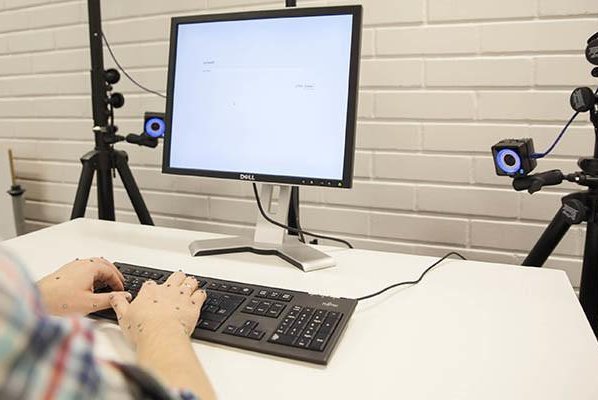High-speed cameras tracked the movement of typists' hands as they performed basic typing tasks and speed tests. Photo by Aalto University/Mikko Raskinen
HELSINKI, Finland, Feb. 9 (UPI) -- Handwriting is rarely taught in schools. Typing instruction, on the other hand, is now routine. And while proper form may be helpful for those just starting out, new research suggests self-taught typists can be equally effective.
Most codified typing techniques -- whether they're being taught to grade school students or retirees -- demand the use of all ten fingers, or as many as physically possible. But a study out of Finland suggests typists can sacrifice a few digits while still achieving speed and efficiency on the keyboard.
The study measured the typing speeds of those who were self-taught and those who had taken a "touch typing" course. Study participants ranged in age and typing skill level.
"We were surprised to observe that people who took a typing course, performed at similar average speed and accuracy, as those that taught typing to themselves and only used six fingers on average," researcher Anna Feit, a doctoral candidate at Aalto University, said in a news release.
Feit and her research partners used high speed cameras and reflective markers placed on the participants' fingers to track each person's typing speed and technique.
"When you ask a person which fingers they use for typing, they cannot tell much," said researcher Daryl Weir. "The motion tracking data exposes it, and for the first time we can exactly say which finger presses which key."
Their analysis showed a variety of strategies, with self-taught typists both sharing traits and employing distinct techniques. Participants used similar strategies to both speedy and sluggish ends. Researchers believe the uniqueness of self-taught techniques are likely influenced by the types of computer tasks people perform on a daily basis -- whether it's playing games, editing photos, typing code or chatting online.
The traditional touch typing technique was developed for word processing on a typewriter, and is likely not optimal for the today's technologically adept computer users.
"It is not advantageous for Photoshop shortcuts or gaming, often done with one hand on the mouse," Feit said.
But the new research proved a ten-finger strategy did offer one advantage. Those who took a typing course tended to spend less time staring at their fingers and more time focusing on the screen, which could prove beneficial for complex editing tasks.















